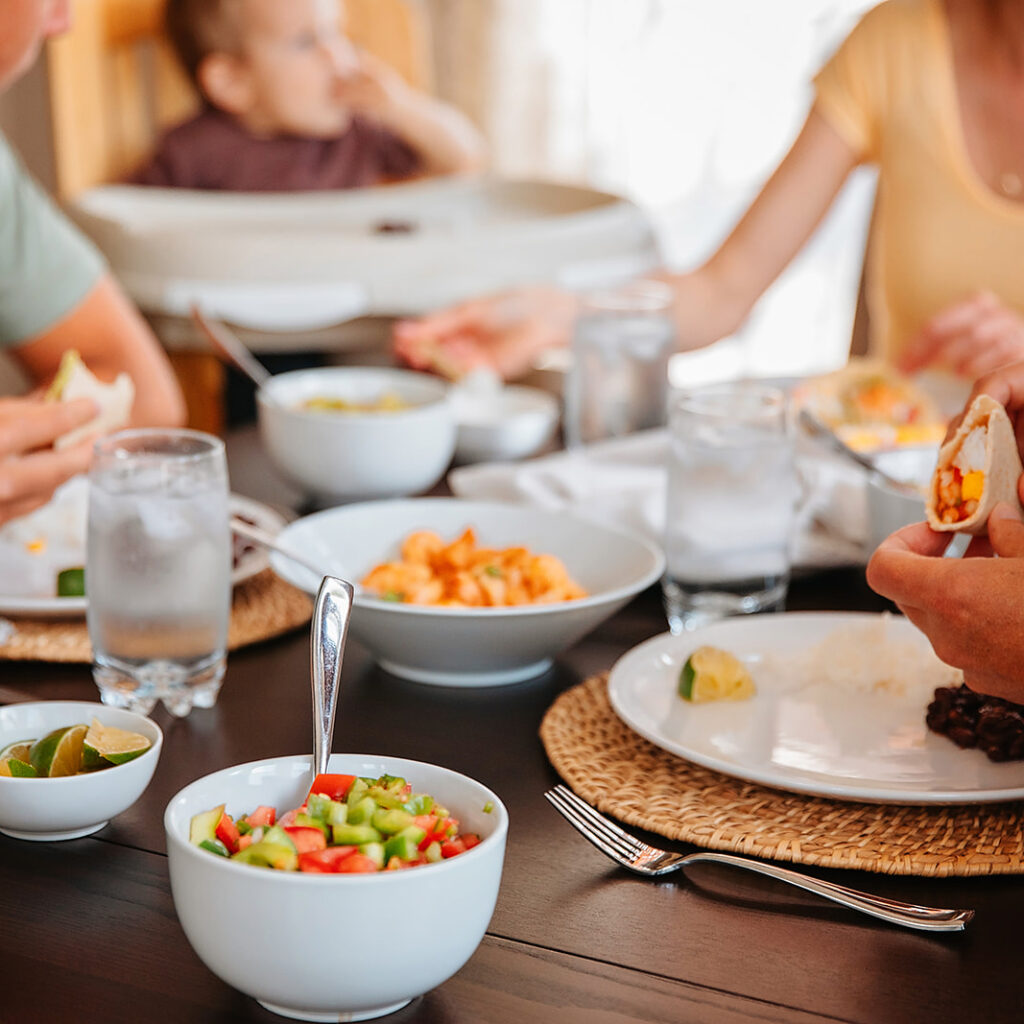The “Division of Responsibility” will help your picky eater try new foods in a safe, low-pressure environment. Here’s what to do – and what NOT to do – for picky eaters.
Picky eating is a frustrating and challenging experience for everyone involved. It’s a biologically normal phase that happens between one to five years of age. However, parents need to guide their children through the phase so they don’t get “stuck” and become adult picky eaters.
The good news? For both picky children AND picky adults there are many ways to encourage adventurous eating.
It IS possible to reverse picky eating!
The Division of Responsibility is foundational to help your picky eater through this phase. For more about picky eating, make sure to read our recent post: 7 Tips to Help your Picky Eater Like More Foods.
Note: this does not constitute medical advice. Neurodivergent children may need more support than what is offered here. If you’re concerned, make sure to contact your pediatrician or a registered dietitian.

What is the Division of Responsibility?
The Division of Responsibility is a concept developed by Registered Dietitian Ellyn Satter. It separates the responsibilities of eating into those for which the adult is responsible and those for which the child is.
This division allows children to listen to their hunger and fullness cues to nurture their innate intuitive eater. Parents maintain the consistency and structure to ensure the child is offered a variety of foods to meet nutritional needs.
We typically think of the division of responsibility in terms of children, but this framework can also help adult picky eaters give themselves a safe space to explore new foods.
The Adult’s Jobs in the Division of Responsibility for Picky Eating
Parents have the “tough job” in the Division of Responsibility. It’s the adult who needs to decide WHAT, WHEN, and WHERE to eat. These questions are too complicated for a small child to answer.
Eventually the roles with transition as children get over and they should have more input. In the early years (especially during toddlerhood), it’s important for parents to make these decisions.
The Adult Decides WHAT to Serve for Meals and Snacks
 There are too many decision-making factors for your child to answer the question of “what” is for dinner. As the adult, your job is to decide what is on the menu for the day.
There are too many decision-making factors for your child to answer the question of “what” is for dinner. As the adult, your job is to decide what is on the menu for the day.
Offer your child a nutritiously balanced meal including protein, carbohydrates, and fruits or vegetables. In addition, always offer your child a “safe food.”
A “safe food” is one which you know your child will eat. Make sure the safe food is easy for YOU – I recommend a safe food you don’t need to cook, like yogurt, cereal, or fruit. It’s okay to offer several choices, but don’t give too many options as this can be overwhelming for your child.
The main meal you cook will give your child exposure to new foods and the “safe food” will give you reassurance that your child has something to eat.
The Adult Decides WHEN to Serve Meals and Snacks
For small children, plan to offer 3 meals with 2-3 snacks each day. The schedule doesn’t need to be rigid, but offering food at specific times can help your child eat better at meals.
If your child “grazes” all day long, snacking on crackers or sipping on milk, they’ll be full (or at least full enough) that they might not be interested in the meal you spent all that time preparing.
Additionally, eating or snacking continuously throughout the day can make it difficult to tune into hunger and fullness cues. Structure around the timing of meals and snacks provides your child the opportunity to understand their body and nutritional needs.
On the other hand, if it’s been too long since the last meal and your child is overly hungry, this can make them less likely to try new foods. They might be so cranky they refuse to eat! In this case, offer a “safe” food to your child first, then once the ravenous hunger has subsided you can try offering other options.
The Adult Decides WHERE to Serve Meals and Snacks
 Children learn the social structure of how to eat by watching others. Having mealtime as a family where everyone sits down to the table together is a great way to model manners, connect with each other over conversation, and teach your children that food is a social experience as well as nutritional.
Children learn the social structure of how to eat by watching others. Having mealtime as a family where everyone sits down to the table together is a great way to model manners, connect with each other over conversation, and teach your children that food is a social experience as well as nutritional.
In addition, family mealtime gives young eaters a chance to watch you eat a wide variety of food. As children go through their “picky” phase (usually between ages 1-5 years), they’ll gain exposure to foods that they might not be comfortable eating.
Families are busy, so it’s probably not possible to sit down at the table for every single meal. If your schedule is really busy, start with scheduling one or two days per week when you can all sit down at the table together. You don’t have to be “perfect” in order to model healthy eating habits!
The Child’s Job in the Division of Responsibility for Picky Eating
Children are born natural intuitive eaters: they eat when they’re hungry and they don’t eat when they’re full. In the Division of Responsibility, the child’s job is to listen to their hunger and fullness cues. Encouraging your child to do so will help them carry this intuitive eating knowledge into adulthood.
The Child Decides IF they will Eat
 Sometimes your child will not want to eat what you make for dinner. This has less to do about you or what you cook and everything about how your child feels in their body at that given moment.
Sometimes your child will not want to eat what you make for dinner. This has less to do about you or what you cook and everything about how your child feels in their body at that given moment.
Allowing your child to say “no” to eating is extremely important for them to feel safe to say “yes!” to it in the future. Remove the pressure for your child to eat a food (or even take a bite) and instead focus on food “exposures.”
It can take up to 20 “exposures” to a food before your child will feel comfortable eating it. The good news is an “exposure” can come in many different forms. Examples of food exposures include:
- Seeing the food on the table
- Playing with the food (think: broccoli trees or jiggling Jell-o)
- Watching you eat a food
- Putting the food in their mouth and then spitting it back out
Focus on offering nutritionally balanced meals and a “safe food” for your child, then allow your child to decide whether or not they will eat.
The Child Decides HOW MUCH they will Eat
A child’s growth is not linear, so their appetite won’t be, either! It’s normal for a child to eat WILDLY different amounts of food from day to day or meal to meal.
Avoid pressuring your child to eat, requiring them to clean their plate, or making them eat a certain food before serving dessert. Doing so can accidentally send the message to your child that some foods are more desirable than others. It can also interfere with your child’s ability to tune into their hunger and fullness cues.
If you’re having trouble with your kiddo wanting to get up and play instead of sitting at the table, try engaging them in conversation. Even your toddler wants to be included! Making sure they’re a part of the group will help them be more willing to sit for longer periods of time.
How the Division of Responsibility Helps with Picky Eating
There are several big benefits of following this division of responsibility for picky eating.
The first is that the tough questions go to the adult. Decisions like “what’s for dinner?” aren’t developmentally appropriate for a toddler (I mean, I’m an adult and I’m barely capable of this).
It can also reduce the stress around meal time. Instead of emptying the refrigerator and pantry onto your child’s plate per their every request, you can hold some healthy boundaries to help keep your sanity.
You also allow your child to tune into their innate hunger and fullness cues. They won’t be stuffing themselves to “earn” dessert. In the long run, they’ll learn they can trust their body to tell them when and how much to eat.

What to Do if Your Child Refuses What You Serve
If you have a toddler, there are going to be some hard dinner moments. Because if you have a toddler, there are going to be hard moments in EVERY situation.
When your child kicks and screams about getting into their high chair, the first thing to do is make sure their basic needs are met. Are they exhausted? Sick? Is your child TOO hungry? Do they just need a hug? Sometimes fixing these basic biological needs can turn dinnertime around!
The second thing to do is to always offer a “safe” food at the meal. A “safe” food is one which you know your child will eat, so even if they refuse the main meal they still have an option for something to eat if they’re hungry.
If you’ve tried all the things and given your child several choices for safe foods and they’re still refusing to eat, it’s okay to set boundaries around food.
 Here’s a helpful script to follow:
Here’s a helpful script to follow:
- Empathize with their request, then
- Hold your boundary
It might look like this: “You really wish you could have an ice cream sandwich for breakfast. Ice cream isn’t on the menu today. Would you like to have frozen waffles or a banana?”
Responding first with empathy helps your child feel seen and heard, which is always step 1 in de-escalating high emotion situations. It might not work all the time, but if you DON’T add in this step, it will likely only escalate.
Holding the boundary without moralizing food gives your child predictability without placing judgment on food choices. Notice the response wasn’t that ice cream has too much sugar and so can’t be a breakfast option – rather it’s simply not on the menu today.
If you’d like, you can add “ice cream sandwich” to the menu on a different day, but you probably won’t offer this every single day because you as the parent understand your child has different nutritional needs which aren’t met by ice cream alone.
How the Division of Duty Can Help Adult Picky Eaters
Reversing picky eating in adulthood uses similar strategies to those used in childhood. The difference is that the adult looks to their inner child for this “child” half of the division of duty.
For example: your rational, “adult” self would choose the menu, the timing, and the location where to eat using the approach described above:
- WHAT: Focus on nutritional balance including the new food you’d like to try AND a safe food you know you like.
- WHEN: Timing of meals varies for adults, but a good rule of thumb is to eat about 3-4 hours apart, or when your hunger is a 3-4 on a hunger scale of 1-10.
- WHERE: Remove distractions such as television or reading and choose a location to eat where you’re comfortable physically and emotionally.
When you eat your meal, allow your inner child to decide IF and HOW MUCH to eat. If you’re willing to take a bite of the new food, please do so! Allow yourself to spit the food out if you don’t like it; you don’t need to force yourself to eat something you don’t want. As with children, the key is safe exposure to food.

If you’re trying to learn to like a food which you previously had a bad experience with, this process will take longer. You first must unlearn the fear and anxiety that came with eating the food before you’ll be able to have a positive experience.
Give yourself time, grace, and continually remind yourself that this is a process. You can stop at any time. Or you can continue to try a food to see if you’ll like it. The more you try this process with different foods, you may be surprised at how quickly you learn to like new things!
How to Increase Variety in your Family’s Meal Plan
If that question of “What’s for dinner?” continues to stress you out, our meal planning app can help! Create a free account in the Peas and Hoppy Meal Guides app and get instant access to a week’s menu with fresh meal ideas, complete with recipes and a grocery list.
 Dietitian Ann (that’s me) has already balanced the meals so they’re nutritionally complete AND we’ve written the recipes to bring out the best flavors in all kinds of foods.
Dietitian Ann (that’s me) has already balanced the meals so they’re nutritionally complete AND we’ve written the recipes to bring out the best flavors in all kinds of foods.
If you love the sample meal plan in the free account, you can subscribe to the app for just $14.99 a month and get a NEW seasonal menu sent to you every week. Customize it to be gluten-free, dairy-free, vegetarian, or vegan. Add or delete recipes from your plan using our database of 800+ options. Enjoy the made-for-you grocery list that will save you so much time and money at the grocery store.
Navigating picky eating and figuring out what to serve your family for dinner can feel overwhelming. Let us take the stress out of the “What’s for dinner?” question!
For more tips to help your picky eater enjoy more foods, check out our blog post: 7 Tips to Help Prevent and Reverse Picky Eating.
Most importantly, remember: you’re doing great. It feels hard because it IS hard. You got this. You can do hard things.
Happy eating adventures,
Dietitian Ann
More Variety at Mealtime
You’re a busy parent; your time is precious. Don’t waste it searching for dinner ideas or risking a recipe that might not turn out!
Download the Peas and Hoppy Meal Guides app and we’ll send you a new menu every week with fresh meal ideas written and tested in Dietitian Ann’s home kitchen. Enjoy fresh variety, more time with your family, and less time planning meals.
“Before the Meal Guides I was struggling with having variety in my meal planning and not many vegetarian options. We eat a lot more fish & vegetarian entrees now which are a great addition to our previous meat & potatoes fare.”
-Margaret S., premium subscriber of the Peas & Hoppy Meal Guides
Meal Planning Made Easy
Download this free meal planning template and learn our easy 3-step process for planning meals around your life – instead of the other way around.

